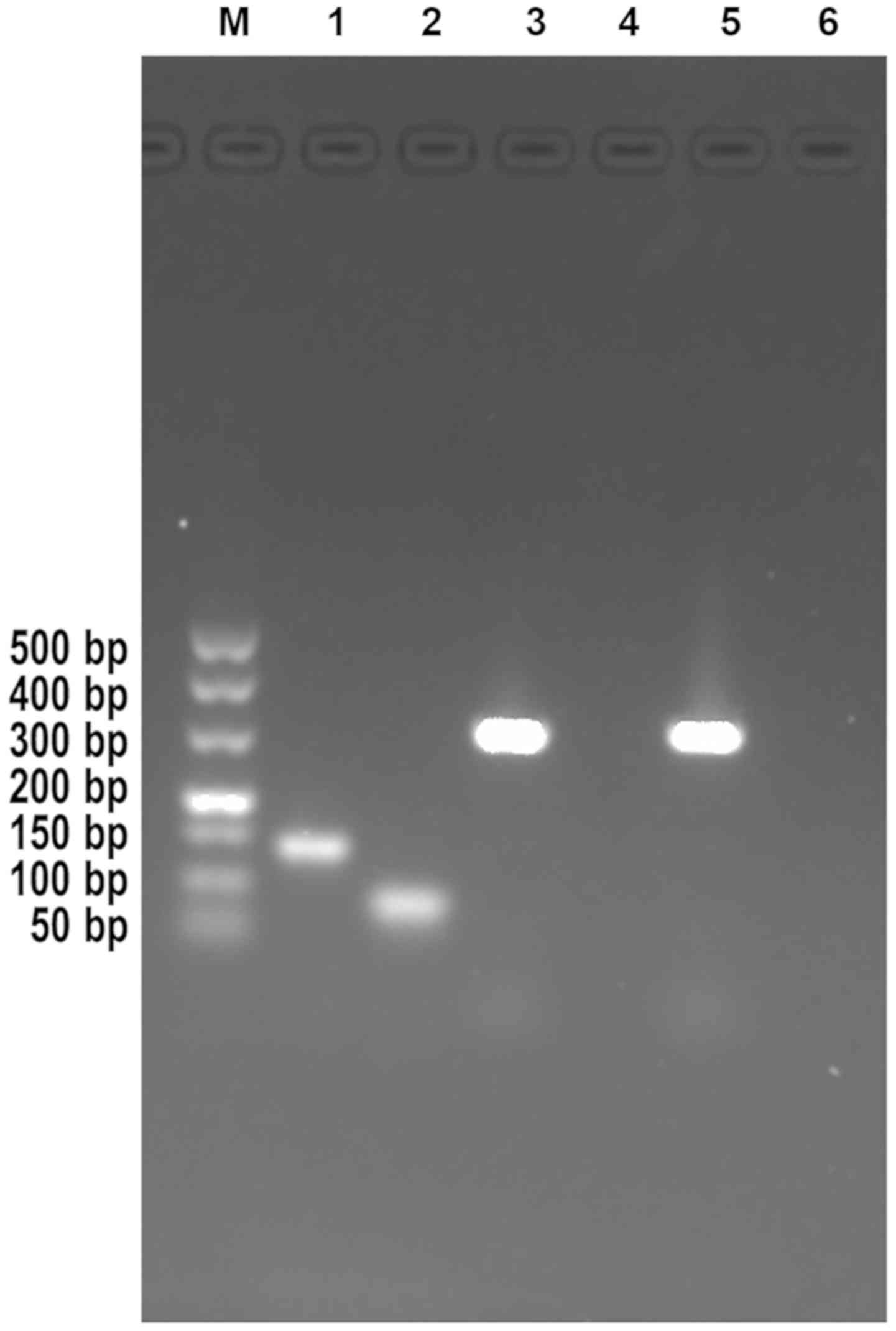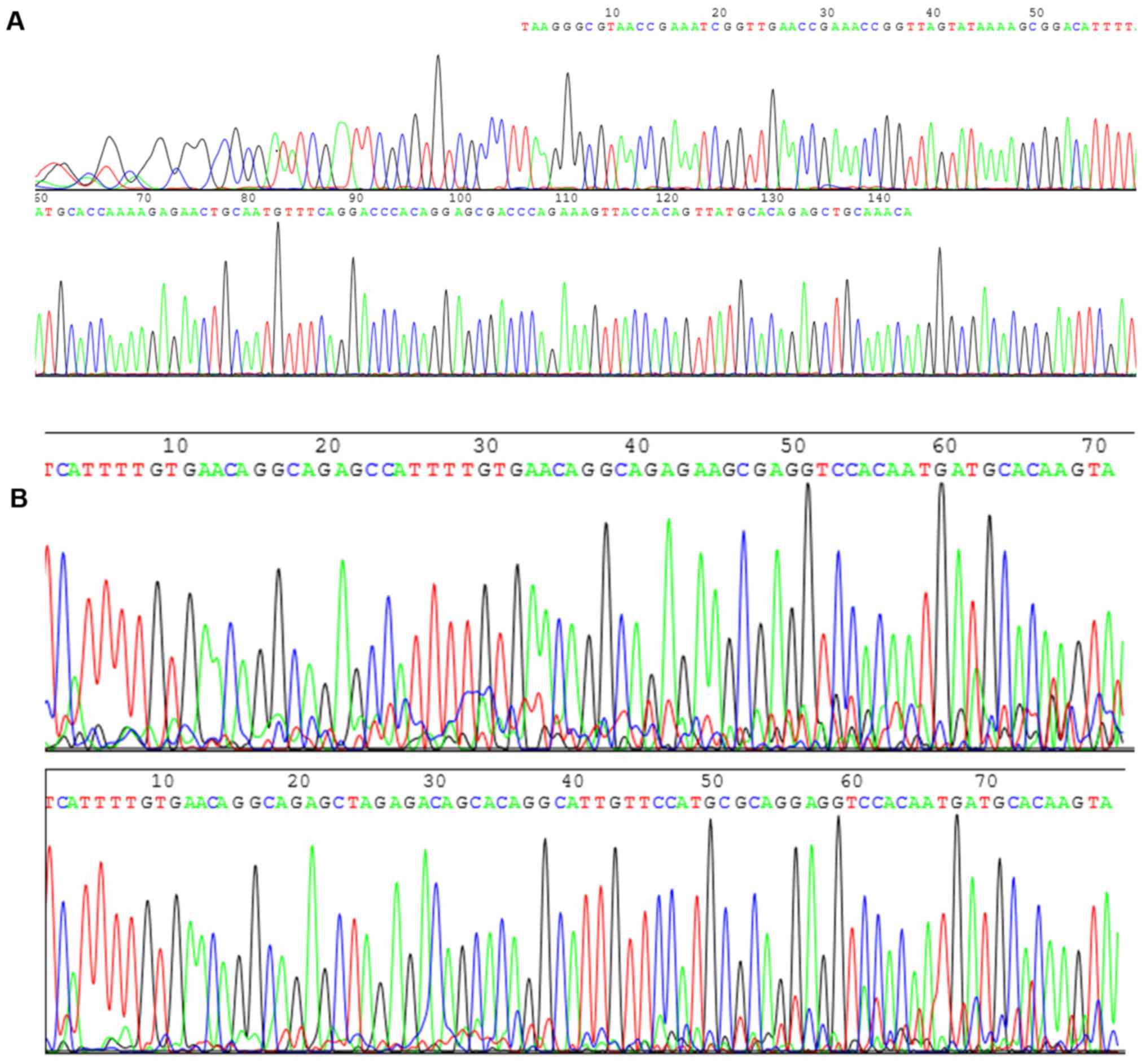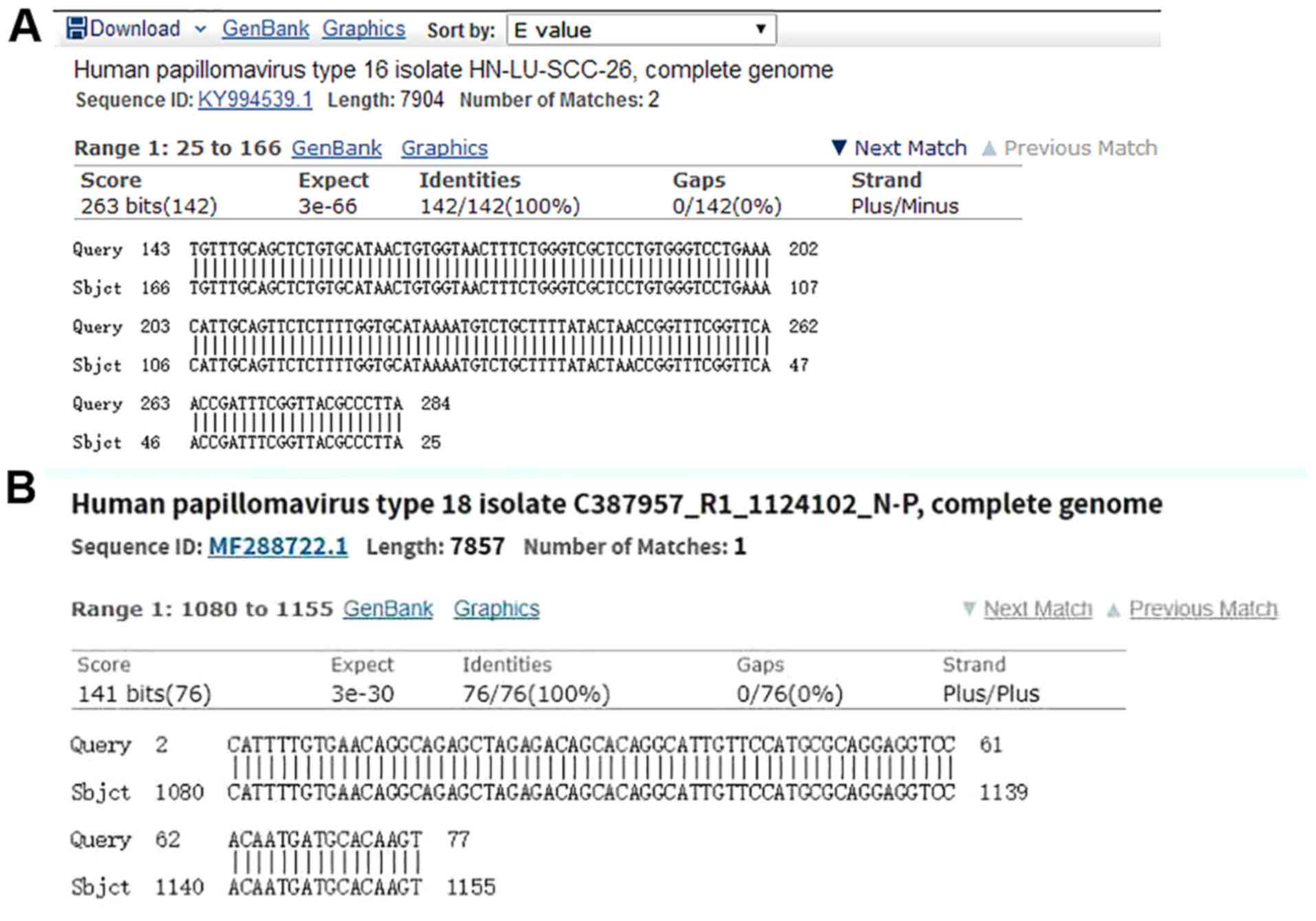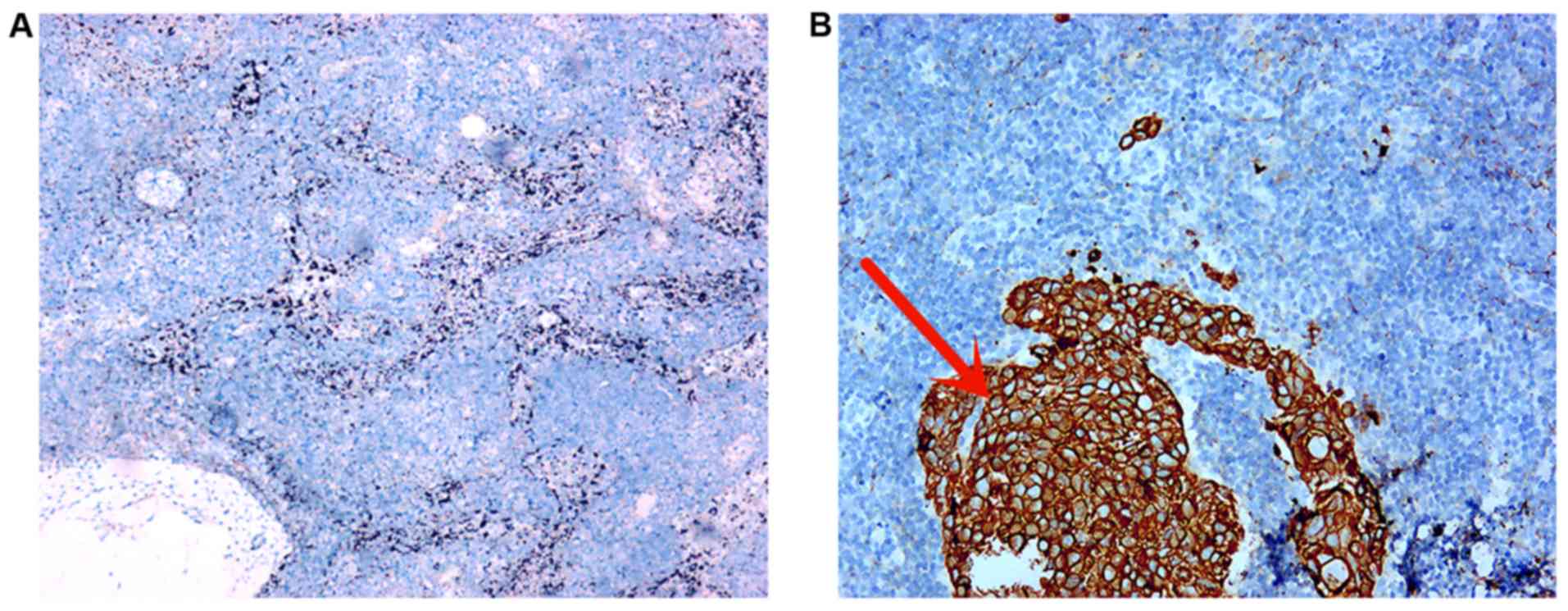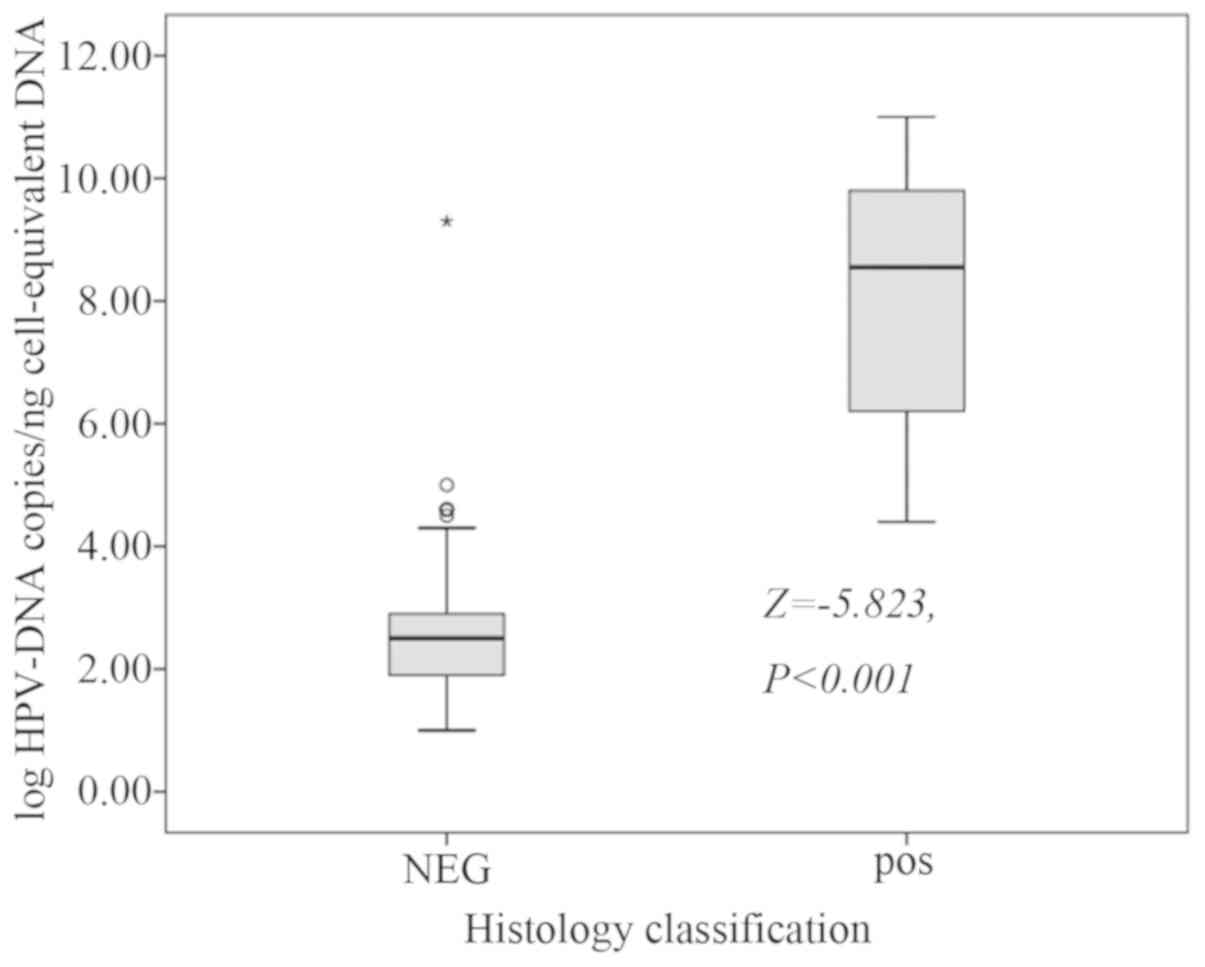|
1
|
Delgado G, Bundy BN, Fowler WC Jr, Stehman
FB, Sevin B, Creasman WT, Major F, DiSaia P and Zaino R: A
prospective surgical pathological study of stage I squamous
carcinoma of the cervix: A gynecologic oncology group study.
Gynecol Oncol. 35:314–320. 1989. View Article : Google Scholar : PubMed/NCBI
|
|
2
|
Slama J, Dundr P, Dusek L and Cibula D:
High false negative rate of frozen section examination of sentinel
lymph nodes in patients with cervical cancer. Gynecol Oncol.
129:384–388. 2013. View Article : Google Scholar : PubMed/NCBI
|
|
3
|
Lentz SE, Muderspach LI, Felix JC, Ye W,
Groshen S and Amezcua CA: Identification of micrometastases in
histologically negative lymph nodes of early-stage cervical cancer
patients. Obstet Gynecol. 103:1204–1210. 2004. View Article : Google Scholar : PubMed/NCBI
|
|
4
|
Okamoto S, Niikura H, Nakabayashi K,
Hiyama K, Matoda M, Takeshima N, Watanabe M, Nagase S, Otsuki T and
Yaegashi N: Detection of sentinel lymph node metastases in cervical
cancer: Assessment of KRT19 mRNA in the one-step nucleic acid
amplification (OSNA) method. Gynecol Oncol. 130:530–536. 2013.
View Article : Google Scholar : PubMed/NCBI
|
|
5
|
Huang BX and Fang F: Progress in the study
of lymph node metastasis in early-stage cervical cancer. Curr Med
Sci. 38:567–574. 2018. View Article : Google Scholar : PubMed/NCBI
|
|
6
|
Bostick PJ, Chatterjee S, Chi DD, Huynh
KT, Giuliano AE, Cote R and Hoon DS: Limitations of specific
reverse-transcriptase polymerase chain reaction markers in the
detection of metastases in the lymph nodes and blood of breast
cancer patients. J Clin Oncol. 16:2632–2640. 1998. View Article : Google Scholar : PubMed/NCBI
|
|
7
|
Van Trappen PO, Gyselman VG, Lowe DG, Ryan
A, Oram DH, Bosze P, Weekes AR, Shepherd JH, Dorudi S, Bustin SA
and Jacobs IJ: Molecular quantification and mapping of lymph-node
micrometastases in cervical cancer. Lancet. 357:15–20. 2001.
View Article : Google Scholar : PubMed/NCBI
|
|
8
|
Lukaszuk K, Liss J, Gulczynski J, Nowaczyk
M, Nakonieczny M, Piatkowski M, Sliwinski W, Baay M, Wozniak I, Maj
B and Lukaszuk M: Predictive value of HPV DNA in lymph nodes in
surgically treated cervical carcinoma patients-a prospective study.
Gynecol Oncol. 104:721–726. 2007. View Article : Google Scholar : PubMed/NCBI
|
|
9
|
Carow K, Read C, Häfner N, Runnebaum IB,
Corner A and Dürst M: A comparative study of digital PCR and
real-time qPCR for the detection and quantification of HPV mRNA in
sentinel lymph nodes of cervical cancer patients. BMC Res Notes.
10:5322017. View Article : Google Scholar : PubMed/NCBI
|
|
10
|
Petry KU, Liebrich C, Luyten A, Zander M
and Iftner T: Surgical staging identified false HPV-negative cases
in a large series of invasive cervical cancers. Papillomavirus Res.
4:85–89. 2017. View Article : Google Scholar : PubMed/NCBI
|
|
11
|
Coutant C, Barranger E, Cortez A, Dabit D,
Uzan S, Bernaudin JF and Darai E: Frequency and prognostic
significance of HPV DNA in sentinel lymph nodes of patients with
cervical cancer. Ann Oncol. 18:1513–1517. 2007. View Article : Google Scholar : PubMed/NCBI
|
|
12
|
Slama J, Drazdakova M, Dundr P, Fischerova
D, Zikan M, Pinkavova I, Freitag P, Fanta M, Kuzel D, Zima T and
Cibula D: High-risk human papillomavirus DNA in paraaortic lymph
nodes in advanced stages of cervical carcinoma. J Clin Virol.
50:46–49. 2011. View Article : Google Scholar : PubMed/NCBI
|
|
13
|
Dürst M, Hoyer H, Altgassen C, Greinke C,
Häfner N, Fishta A, Gajda M, Mahnert U, Hillemanns P, Dimpfl T, et
al: Prognostic value of HPV-mRNA in sentinel lymph nodes of
cervical cancer patients with pN0-status. Oncotarget.
6:23015–23025. 2015. View Article : Google Scholar : PubMed/NCBI
|
|
14
|
Bhatla N, Aoki D, Sharma DN and
Sankaranarayanan R: FIGO Cancer Report 2018. Int J Gynecol Obstet.
143 (Suppl 2):S22–S36. 2018. View Article : Google Scholar
|
|
15
|
Kawase J, Asakura H, Kurosaki M, Oshiro H,
Etoh Y, Ikeda T, Watahiki M, Kameyama M, Hayashi F, Kawakami Y, et
al: Rapid and accurate diagnosis based on real-time PCR cycle
threshold value for the identification of campylobacter jejuni,
astA gene-positive escherichia coli, and eae gene-positive E. coli.
Jpn J Infect Dis. 71:79–84. 2018. View Article : Google Scholar : PubMed/NCBI
|
|
16
|
Cibula D, Zikana M, Slama J, Fischerova D,
Kocian R, Germanova A, Burgetova A, Dusek L, Dundr P, Gregova M and
Nemejcova K: Risk of micrometastases in non-sentinel pelvic lymph
nodes in cervical cancer. Gynecol Oncol. 143:83–86. 2016.
View Article : Google Scholar : PubMed/NCBI
|
|
17
|
Wiebe E, Denny L and Thomas G: Cancer of
the cervix uteri. Int J Gynaecol Obstet. 119 (Suppl 2):S100–S109.
2012. View Article : Google Scholar : PubMed/NCBI
|
|
18
|
Doorbar J, Egawa N, Griffin H, Kranjec C
and Murakami I: Human papillomavirus molecular biology and disease
association. Rev Med Virol. 25 (Suppl 1):S2–S23. 2015. View Article : Google Scholar
|
|
19
|
Biesaga B, Janecka A, Mucha-Małecka A,
Adamczyk A, Szostek S, Słonina D, Halaszka K and Przewoźnik M:
HPV16 detection by qPCR method in relation to quantity and quality
of DNA extracted from archival formalin fixed and paraffin embedded
head and neck cancer tissues by three commercially available kits.
J Virol Methods. 236:157–163. 2016. View Article : Google Scholar : PubMed/NCBI
|
|
20
|
Schroeder L, Boscolo-Rizzo P, Dal Cin E,
Romeo S, Baboci L, Dyckhoff G, Hess J, Lucena-Porcel C, Byl A,
Becker N, et al: Human papillomavirus as prognostic marker with
rising prevalence in neck squamous cell carcinoma of unknown
primary: A retrospective multicentre study. Eur J Cancer. 74:73–81.
2017. View Article : Google Scholar : PubMed/NCBI
|
|
21
|
Fuglsang K, Blaakaer J, Petersen LK,
Mejlgaard E, Hammer A and Steiniche T: Detection of high-risk human
papillomavirus DNA in tissue from primary cervical cancer tumor,
pelvic lymph nodes and recurrent disease. Papillomavirus Res.
7:15–20. 2019. View Article : Google Scholar : PubMed/NCBI
|
|
22
|
Cancer Genome Atlas Research Network;
Albert Einstein College of Medicine; Analytical Biological
Services; Barretos Cancer Hospital; Baylor College of Medicine;
Beckman Research Institute of City of Hope; Buck Institute for
Research on Aging; Canada's Michael Smith Genome Sciences Centre;
Harvard Medical School; Helen F. Graham Cancer Center &Research
Institute at Christiana Care Health Services et al, . Integrated
genomic and molecular characterization of cervical cancer. Nature.
543:378–384. 2017. View Article : Google Scholar : PubMed/NCBI
|
|
23
|
Arbyn M, Tommasino M, Depuydt C and
Dillner J: Are 20 human papillomavirus types causing cervical
cancer? J Pathol. 234:431–435. 2014. View Article : Google Scholar : PubMed/NCBI
|
|
24
|
Hopenhayn C, Christian A, Christian WJ,
Watson M, Unger ER, Lynch CF, Peters ES, Wilkinson EJ, Huang Y,
Copeland G, et al: Prevalence of human papillomavirus types in
invasive cervical cancers from 7 US cancer registries before
vaccine introduction. J Low Genit Tract Dis. 18:182–189. 2014.
View Article : Google Scholar : PubMed/NCBI
|
|
25
|
Mbatani N, Adams T, Wijk LV, Behrens C,
Tam T, Wright T Jr, Stoler M and Denny L: Performance of an human
papillomavirus test in samples from women with
histolopathologically confirmed invasive cervical cancer. J Low
Genit Tract Dis. 20:151–153. 2016. View Article : Google Scholar : PubMed/NCBI
|
|
26
|
Ronco G, Dillner J, Elfström KM, Tunesi S,
Snijders PJ, Arbyn M, Kitchener H, Segnan N, Gilham C, Giorgi-Rossi
P, et al: Efficacy of HPV-based screening for prevention of
invasive cervical cancer: Follow-up of four European randomised
controlled trials. Lancet. 383:524–532. 2014. View Article : Google Scholar : PubMed/NCBI
|
|
27
|
Armaroli P, Villain P, Suonio E, Almonte
M, Anttila A, Atkin WS, Dean PB, de Koning HJ, Dillner L, Herrero
R, et al: European code against cancer, 4th edition: Cancer
screening. Cancer Epidemiol. 39 (Suppl 1):S139–S152. 2015.
View Article : Google Scholar : PubMed/NCBI
|
|
28
|
Carter J, Hammond I and Smith M: The
renewal of the national cervical screening program. Med J Aust.
206:2742017. View Article : Google Scholar : PubMed/NCBI
|
|
29
|
Sawaya GF, Kulasingam S, Denberg TD and
Qaseem A; Clinical Guidelines Committee of American College of
Physicians, : Cervical cancer screening in average-risk women: Best
practice advice from the clinical guidelines committee of the
American college of physicians. Ann Intern Med. 162:851–859. 2015.
View Article : Google Scholar : PubMed/NCBI
|
|
30
|
Zhang F, Liu D, Lin B, Hao Y, Zhou D, Qi Y
and Zhang S: Expression of high-risk HPV DNA and CK19 in pelvic
lymph nodes in stage Ia-IIa cervical cancer and their clinical
value. Oncol Rep. 27:1801–1806. 2012.PubMed/NCBI
|
|
31
|
Lu Y, Wei JY, Yao DS, Pan ZM and Yao Y:
Application of carbon nanoparticles in laparoscopic sentinel lymph
node detection in patients with early-stage cervical cancer. PLoS
One. 12:e01838342017. View Article : Google Scholar : PubMed/NCBI
|
|
32
|
Duvlis S, Popovska-Jankovic K, Arsova ZS,
Memeti S, Popeska Z and Plaseska-Karanfilska D: HPV E6/E7 mRNA
versus HPV DNA biomarker in cervical cancer screening of a group of
Macedonian women. J Med Virol. 87:1578–1586. 2015. View Article : Google Scholar : PubMed/NCBI
|
|
33
|
Lancaster WD, Castellano C, Santos C,
Delgado G, Kurman RJ and Jenson AB: Human papillomavirus
deoxyribonucleic acid in cervical carcinoma from primary and
metastatic sites. Am J Obstet Gynecol. 154:115–119. 1986.
View Article : Google Scholar : PubMed/NCBI
|
|
34
|
Noventa M, Ancona E, Cosmi E, Saccardi C,
Litta P, D'Antona D, Nardelli GB and Gizzo S: Usefulness, methods
and rationale of lymph nodes HPV-DNA investigation in estimating
risk of early stage cervical cancer recurrence: A systematic
literature review. Clin Exp Metastasis. 31:853–867. 2014.
View Article : Google Scholar : PubMed/NCBI
|
|
35
|
Tortora M, Annunziata C, Liguori G, Losito
S, Botti G, Greggi S, Buonaguro L, Buonaguro FM and Tornesello ML:
Detection of human papillomavirus DNA in peri-tumor tissues and
pelvic lymph nodes as potential molecular marker of micrometastasis
in cervical cancer. Infect Agent Cancer. 11:222016. View Article : Google Scholar : PubMed/NCBI
|
|
36
|
Köhler C, Le X, Dogan NU, Pfiffer T,
Schneider A, Marnitz S, Bertolini J and Favero G: Molecular
diagnosis for nodal metastasis in endoscopically managed cervical
cancer: The accuracy of the APTIMA test to detect high-risk human
papillomavirus messenger RNA in sentinel lymph nodes. J Minim
Invasive Gynecol. 23:748–752. 2016. View Article : Google Scholar : PubMed/NCBI
|
|
37
|
Lillo F, Galli L, Lodini S, Taccagni G,
Ferrari A and Origoni M: Extralesional detection and load of human
papillomavirus DNA: A possible marker of preclinical tumor spread
in cervical cancer. J Low Genit Tract Dis. 12:204–209. 2008.
View Article : Google Scholar : PubMed/NCBI
|















